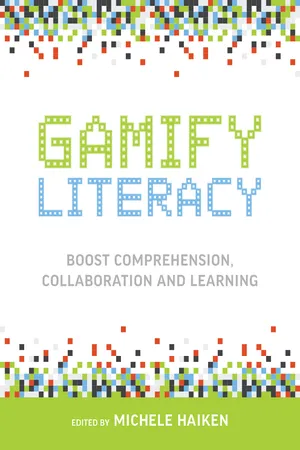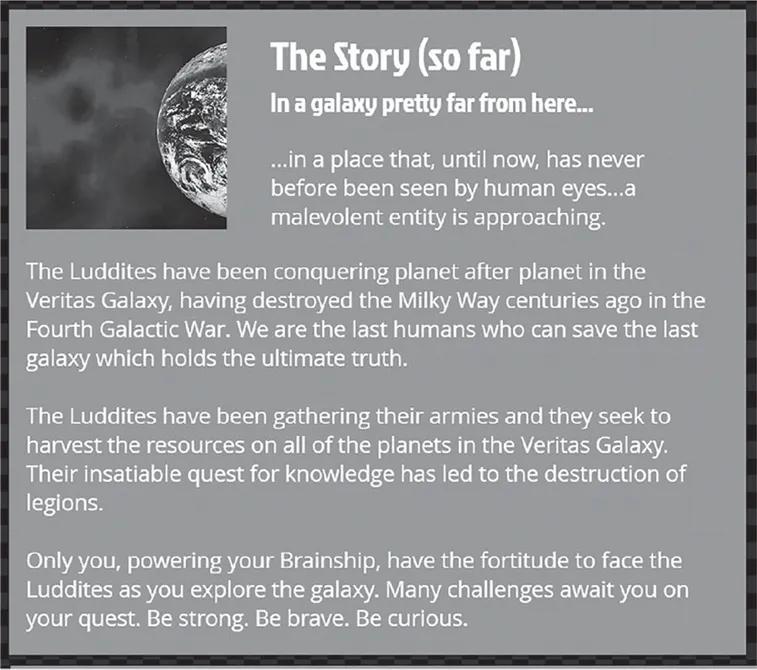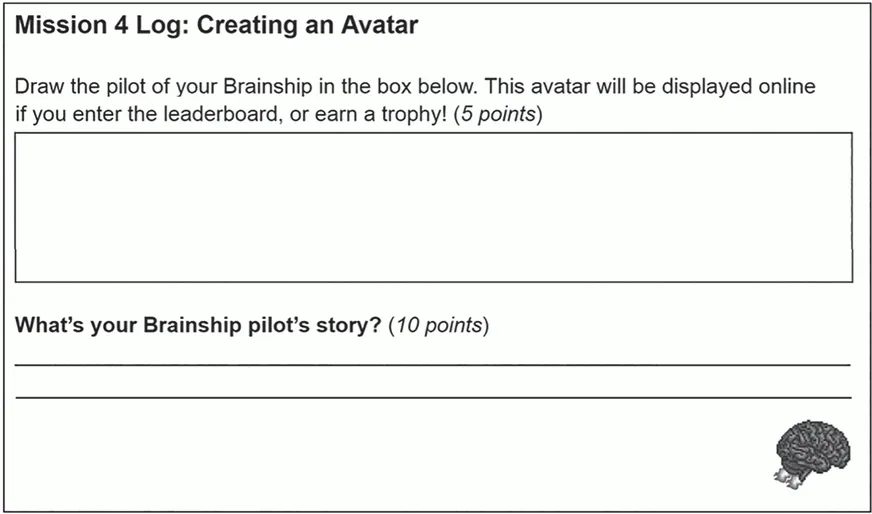
eBook - ePub
Available until 26 Feb |Learn more
Gamify Literacy
Boost Comprehension, Collaboration and Learning
- English
- ePUB (mobile friendly)
- Available on iOS & Android
eBook - ePub
Available until 26 Feb |Learn more
About this book
This friendly, accessible guide offers tips and inspiration on how to apply gamification techniques to improve literacy and deepen student collaboration and critical thinking.
Literacy is at the heart of education — and what better way to teach this important subject than through the motivational techniques built into gamification?
With Gamify Literacy, teacher Michele Haiken brings together top educators and gaming professionals to share gamification strategies, demonstrating how teachers can use game-based tools and activities to improve literacy and content learning.
This book includes:
By exploring the techniques discussed in these pages, you will see the power of building a fully immersive learning environment for your students and can begin infusing these inspirational approaches into your classroom design.
Audience: K-12 language arts teachers, tech coaches
Literacy is at the heart of education — and what better way to teach this important subject than through the motivational techniques built into gamification?
With Gamify Literacy, teacher Michele Haiken brings together top educators and gaming professionals to share gamification strategies, demonstrating how teachers can use game-based tools and activities to improve literacy and content learning.
This book includes:
- Tips for implementing gamification techniques to engage and motivate students.
- Fun and engaging design to complement a game-based approach to learning.
- Examples that can easily be modified for different grade levels.
By exploring the techniques discussed in these pages, you will see the power of building a fully immersive learning environment for your students and can begin infusing these inspirational approaches into your classroom design.
Audience: K-12 language arts teachers, tech coaches
Frequently asked questions
Yes, you can cancel anytime from the Subscription tab in your account settings on the Perlego website. Your subscription will stay active until the end of your current billing period. Learn how to cancel your subscription.
At the moment all of our mobile-responsive ePub books are available to download via the app. Most of our PDFs are also available to download and we're working on making the final remaining ones downloadable now. Learn more here.
Perlego offers two plans: Essential and Complete
- Essential is ideal for learners and professionals who enjoy exploring a wide range of subjects. Access the Essential Library with 800,000+ trusted titles and best-sellers across business, personal growth, and the humanities. Includes unlimited reading time and Standard Read Aloud voice.
- Complete: Perfect for advanced learners and researchers needing full, unrestricted access. Unlock 1.4M+ books across hundreds of subjects, including academic and specialized titles. The Complete Plan also includes advanced features like Premium Read Aloud and Research Assistant.
We are an online textbook subscription service, where you can get access to an entire online library for less than the price of a single book per month. With over 1 million books across 1000+ topics, we’ve got you covered! Learn more here.
Look out for the read-aloud symbol on your next book to see if you can listen to it. The read-aloud tool reads text aloud for you, highlighting the text as it is being read. You can pause it, speed it up and slow it down. Learn more here.
Yes! You can use the Perlego app on both iOS or Android devices to read anytime, anywhere — even offline. Perfect for commutes or when you’re on the go.
Please note we cannot support devices running on iOS 13 and Android 7 or earlier. Learn more about using the app.
Please note we cannot support devices running on iOS 13 and Android 7 or earlier. Learn more about using the app.
Yes, you can access Gamify Literacy by Michele Haiken in PDF and/or ePUB format, as well as other popular books in Education & Education Standards. We have over one million books available in our catalogue for you to explore.
Information
Topic
EducationSubtopic
Education StandardsSECTION 1
Sandbox
Open-Ended, Go-Anywhere Style of Play
IN THIS SECTION
CHAPTER 1 School Research Goes Galactic: Using Game Design to Reimagine Middle School Research Projects by Sheena Kelly
CHAPTER 2 LARPs for Learning: Live Action Role-Play by Aaron Vanek
CHAPTER 3 Game Creation as a Learning Activity for All Students by Kip Glazer
CHAPTER 4 Gamifying Culinary Arts by Tisha Richmond
CHAPTER 5 Game On: How a Non-Gamer Learned to Gamify Her Classroom by Carrie Baughcum
1
School Research Goes Galactic
> Using Game Design to Reimagine Middle School Research Projects
ISTE Standards for Students
1 Empowered Learner. Students leverage technology to take an active role in choosing, achieving and demonstrating competency in their learning goals, informed by the learning sciences.
2 Digital Citizen. Students recognize the rights, responsibilities and opportunities of living, learning and working in an interconnected digital world, and they act and model in ways that are safe, legal and ethical.
3 Knowledge Constructor. Students critically curate a variety of resources using digital tools to construct knowledge, produce creative artifacts, and make meaningful learning experiences for themselves and others.
A colleague recently asked me, “What is gamification?” The first metaphor that sprang to mind was today’s retail shopping experience. Starbucks gamifies your coffee drinking experience by giving you points and rewards for buying drinks, food, and other merchandise. Local grocery stores gamify the chore of grocery shopping by offering special pricing on your favorite foods and giving pennies off your next gas purchase. I’m sure you can think of even more examples of gamification and other incentive systems at play in the everyday activities of your life. The widespread use of games and gaming in our society, means that my middle school students have grown up earning points and rewards for completing everyday tasks.
Prepare to Blast Off!
I grew up as the first console gaming systems were just hitting the retail market. I remember plugging a joystick into my grandfather’s Commodore 64 computer, and I still play my original Super Nintendo gaming system. During my secondary school years, the concept of making mundane tasks into fun and engaging games was not a part of people’s everyday experiences. But as far back as I can remember, I have owned at least one gaming console. Today, I own seven different devices to play games on. And today’s students are even more likely to own gaming consoles earlier in their lives. In the book Hanging Out, Messing Around, and Geeking Out: Kids Learning with New Media, the authors state, “Gaming represents the central form of early computer experience for kids” (Ito et al., 2010). My gaming isn’t confined to the computer, of course. I was raised playing all kinds of games with family and friends. I love board games like Sorry, card games like Fluxx, puzzle games like Portal, racing games like Mario Kart—really all of the games.
I knew I enjoyed games, and I knew my students enjoyed games. I wanted to gamify my research curriculum before I knew what that meant. What I was only vaguely aware of is the fact that “games and simulations yielded better attitudes toward learning when compared to traditional teaching methods and seem to facilitate motivation across different learner groups and learning situations” (Kapp, 2012). And I needed all good attitudes and higher motivation to buy into the content I was peddling. Research projects are a necessary component in developing critical thinking, reasoning abilities, and information literacy skills. I could sense, however, that the middle school students were not fully engaged in the process of inquiry, and many were not fully grasping the concepts I was trying to teach. I knew something had to change. Through my research and experience I knew that “not only is game play time growing among U.S. youth, but forms of game play and gaming demographics are diversifying” (Ito et al., 2010). This trend has continued so much so that some game worlds have even been developed into movies. For example, the 2016 Angry Birds movie and the 2014 Lego Movie are two recent games turned into feature-length films. Even though my love of research was not a passion I could pass on to students, my love of gaming was.
The Veritas Galaxy
As the teacher librarian for grades 6–12, I have the opportunity to teach information literacy skills in collaboration with a variety of different departments. I work on Veritas most closely with middle school social studies teachers. I’m fortunate to work with a group of educators who, with few hesitations, jumped on board when I proposed, “What if we taught students how to research…but in space?” As a K–12 school, we can vertically align our information literacy skills instruction to ensure students graduate with a thorough understanding of how to find and retrieve information in a variety of formats, evaluate that information using several criteria (see Appendix A), and synthesize and apply that information in new contexts. With the classroom teacher’s content knowledge and my understanding of the American Association of School Librarians Standards for the 21st-Century Learner, I built a world where truth was the highest value: The Veritas Galaxy (see Figure 1.1). At the heart of the game is the idea that a process of inquiry can lead to deeper understanding of the world around us. With every new Luddite encounter, students must ask good questions to propel them in their process of discovery.

Figure 1.1. Screenshot of backstory for Veritas Galaxy.

Figure 1.2. Creating an avatar student assignment.
The game progresses during students’ research projects in social studies classes. As teachers introduce students to the assignment, I fly in to teach and enhance information literacy concepts and strategies. Despite my limited student contact, I effectively used backwards design to think through the research concepts that needed to be taught, the American Association of School Librarians (AASL) standards to cover, and overarching gameplay and story development.
In addition to teaching critical information literacy skills, I wanted to teach students about the importance of asking good questions and making informed decisions. I was, therefore, very intentional about the language and rhetoric I used in storytelling and gameplay. Some names are fictional (like Planet Meglaton, ruled by cat people) while some are intellectually meaningful. For example, corpus coins (which are dry pinto beans spray painted silver) can be earned by players during class time instruction for things like finding a typo on a mission data sheet or helping a fellow space traveller in need. Coins can also be lost when students are off task or don’t follow instructions. In reality, the corpus callosum is the part of the brain that forms neural connections between the right and left hemispheres, which I didn’t know before developing the Veritas Galaxy story arc. This thoughtful game-play mechanism helps to make the game universe more convincing and comprehensive. I know much more about celestial bodies and the human brain now than I ever thought I would because of the research done to develop a believable game plot. The game is currently being played in middle school classrooms, though I envision a future expansion of the game (or some derivative form) for high school students.
The sixth grade is my first opportunity to begin information literacy skill instruction, and it’s also where students first encounter the secondary library and the Veritas universe. Because of this, I teach a bonus lesson at the start of the school year about how to utilize the library’s resources. During this lesson, students are asked to read and sign the Explorer’s Creed (see Appendix B) and the rules of play. They then create their avatar and their character’s backstory within the game (see Figure 1.2). Using avatars allows students to become personally invested in the game. I considered a few digital avatar creators: The Lego SigFig Creator (sigfigcreator.thelegomovie.com) and Marvel’s Create Your Own Superhero (marvel.com/games/play/31/create_your_own_superhero) for example, but I found that students were more creative when they had to depend on their own brainships for ideas. This is an easy mission to get all students on the scoreboard and feeling successful. Though game points can be earned and lost individually, students may collaborate on missions during different project assignments.
After students develop their character and backstory, they take the Bartle Test to determine their gamer personality within the Bartle taxonomy of player types. After answering a series of questions about character behavior and in-game preferences, students are given their percentage identification of the following gaming styles: Achiever, Explorer, Gladiator, or Socializer. These results, which are accessible by the teacher, help to customize and differentiate the game depending on the student’s results in each class. Bartle explains the four styles of gamers in the following way:
> Achievers “give themselves game-related goals, and vigorously set out to achieve them.” Goals can be built into the game in the form of assessments (like boss levels) but don’t have to be that big. Smaller components can be built in for players to unlock as they progress.
> Explorers “try to find out as much as they can about the virtual world.” The game universe should be complex enough to not bore the Explorers. Don’t feel, however, that you must have all of the details set in stone before beginning gameplay. Students can always discover or unlock new areas as the game progresses.
> Gladiators “use the tools provided by the game to cause distress to (or, in rare circumstances, to help) other players.” A component of most games is the option of doing harm to another player. Think of the game Sorry where players are encouraged to send their opponents back to the starting line. A little friendly rivalry will help keep Gladiators motivated and engaged.
> Socializers “use the game’s communicative facilities…as a context in which to converse (and otherwise interact) with their fellow players” (Bartle, 1996). It’s important to allow students time to talk and collaborate, and this is especially true for Socializers. Offer opportunities for students to interact with each other throughout the game. For example, the research projects I lead are done in pairs or small groups, but I try to facilitate additional mingling outside of these core partner groups.
These gamer categories can serv...
Table of contents
- Cover
- Title Page
- Copyright
- About ISTE
- About the Editor
- About the Contributors
- Contents
- Foreword
- Introduction
- SECTION 1: Sandbox: Open-Ended, Go-Anywhere Style of Play
- SECTION 2: Homebrews and Game Sharks: Gamification Strategies & Tools to Utilize Across Content Areas
- SECTION 3: Cheats: Gamification Strategies for Success
- Index